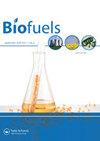储存容器对生物燃料中氧化产物生成影响的实验研究
IF 2.6
4区 工程技术
Q3 ENERGY & FUELS
引用次数: 0
摘要
摘要脂肪酸甲酯(FAME)既可以作为一种独立的燃料,也可以作为石油柴油的组分。不幸的是,它对氧化过程的抵抗力非常差。本文介绍了一次和二次氧化产物作为抗氧化性的决定因素的测试。基于过氧化值的变化,确定了生物燃料FAME的氧化动力学。在本研究中,观察到密度和粘度的增加,这是由二次氧化产物的转化以及含有双键的脂肪酸酯的聚合和缩聚反应形成的聚合物沉积物引起的。测量结果表明,苯胺值与过氧化值之间存在直接关系。在将FAME储存在钢制容器中的过程中,FAME样品中存在的水加速了一次和二次氧化产物的形成。动力学研究揭示了生物燃料老化动力学的变化,这表明储存时间对燃料质量的负面影响。本文章由计算机程序翻译,如有差异,请以英文原文为准。
An experimental investigation on the influence of storage container on the development of oxidised products in biofuel
Abstract Fatty acid methyl ester (FAME) can be used both as an independent fuel and as a component for petrodiesels. Unfortunately, it is very poorly resistant to oxidation processes. The paper presents tests of primary and secondary oxidation products as a determinant of oxidation resistance. Based on changes in the peroxide number, the oxidation kinetics of the biofuel FAME was determined. In the present study, an increase in density and viscosity was observed, caused by the formation of polymer deposits resulting from the transformation of secondary oxidation products and the polymerization and polycondensation reactions of fatty acid esters containing a double bond. The measurement results show a direct relationship between the anisidine number and the peroxide number. The presence of water in the FAME samples accelerates the formation of primary and secondary oxidation products during the storage of the FAME in a steel container. The kinetics study revealed a change in the biofuel aging kinetics, which indicates the negative impact of storage time on fuel quality.
求助全文
通过发布文献求助,成功后即可免费获取论文全文。
去求助
来源期刊

Biofuels-Uk
Energy-Renewable Energy, Sustainability and the Environment
CiteScore
5.40
自引率
9.50%
发文量
56
期刊介绍:
Current energy systems need a vast transformation to meet the key demands of the 21st century: reduced environmental impact, economic viability and efficiency. An essential part of this energy revolution is bioenergy.
The movement towards widespread implementation of first generation biofuels is still in its infancy, requiring continued evaluation and improvement to be fully realised. Problems with current bioenergy strategies, for example competition over land use for food crops, do not yet have satisfactory solutions. The second generation of biofuels, based around cellulosic ethanol, are now in development and are opening up new possibilities for future energy generation. Recent advances in genetics have pioneered research into designer fuels and sources such as algae have been revealed as untapped bioenergy resources.
As global energy requirements change and grow, it is crucial that all aspects of the bioenergy production process are streamlined and improved, from the design of more efficient biorefineries to research into biohydrogen as an energy carrier. Current energy infrastructures need to be adapted and changed to fulfil the promises of biomass for power generation.
Biofuels provides a forum for all stakeholders in the bioenergy sector, featuring review articles, original research, commentaries, news, research and development spotlights, interviews with key opinion leaders and much more, with a view to establishing an international community of bioenergy communication.
As biofuel research continues at an unprecedented rate, the development of new feedstocks and improvements in bioenergy production processes provide the key to the transformation of biomass into a global energy resource. With the twin threats of climate change and depleted fossil fuel reserves looming, it is vitally important that research communities are mobilized to fully realize the potential of bioenergy.
 求助内容:
求助内容: 应助结果提醒方式:
应助结果提醒方式:


